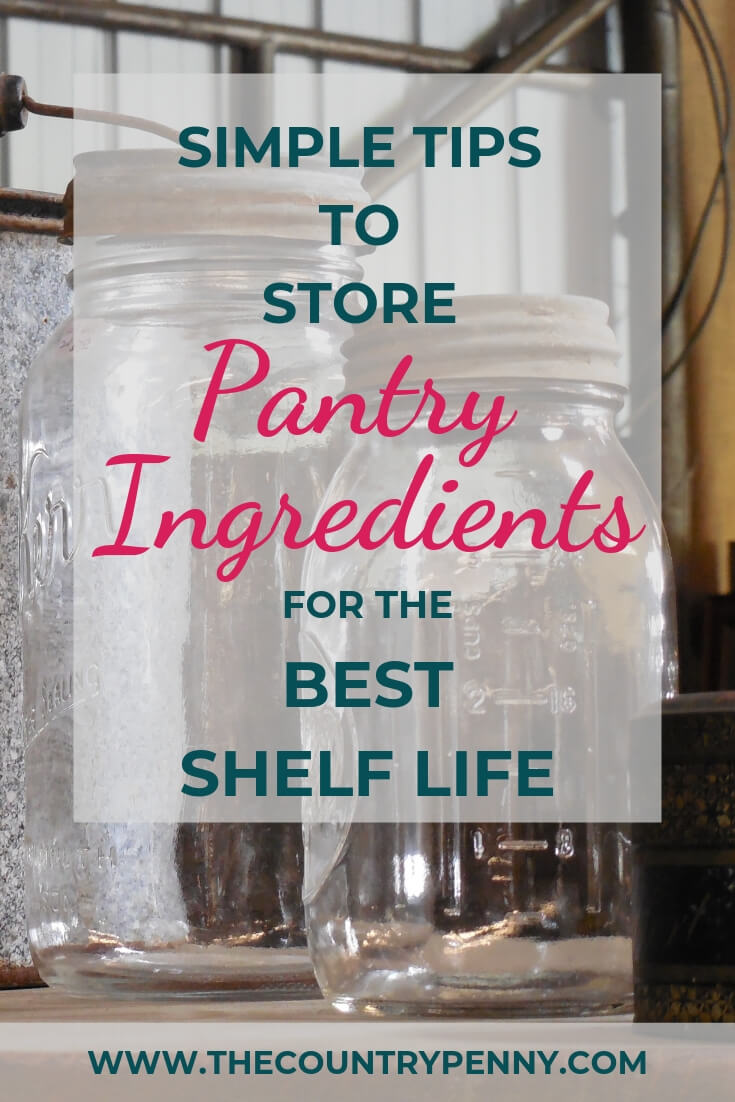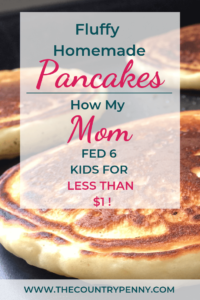Don’t have time to read it now? Pin it for later!
I hate to meal plan.
Since I never meal plan, having a fully stocked pantry allows me to easily cook from home.
I’m a huge fan of cooking from your pantry. I don’t have to go to the grocery store in order to cook dinner, it saves me tons of money, and I really love knowing that I have all the ingredients available to cook simple but delicious meals for my family.
If you’re just starting to stock your pantry go check out my post on how to stock a pantry that you’ll actually like cooking from. It will teach you all the basics of how to stock a pantry or you can sign up below to get a full list of all my pantry staples.

Now that you’ve started to buy your pantry ingredients you’re realizing you have no idea how to actually store all of this food! It all comes in big bags or huge boxes. Or it’s frozen and all you’ve ever kept in the freezer is ice cream.
How on earth are you supposed to store all of this so it doesn’t go bad? In the future I’ll write a post on storing specific foods, but here is a basic overview of how to store your pantry cooking ingredients so that they won’t go bad before you use them.
Dry Goods
Dry goods like flour, sugar, salt, and dry beans can all be stored at room temperature in sealed buckets. Try to keep flour at room temperature or cooler or it can go rancid.
I’ve only had it happen once, while I was living in a camp trailer with no air conditioning. The flour was in a five-gallon bucket in front of the window and it got really, really hot. The temperature inside of the camp trailer was up to about 115° and the bucket was even warmer than that. It took some pretty extreme conditions, but it is possible for flour to go bad.
Along the same lines, if you have trouble with bugs like pantry moths, weevils or miller moths in your flour make sure to put it in the freezer for 48 hours. Then put it into airtight buckets and you shouldn’t have any more problems.
Make sure to clean up any flour that gets spilled in your pantry or cupboards right away to prevent bugs from moving in. As long as you don’t provide them a free meal, you should be able to keep them from becoming a problem.
I’ve never had a problem with bugs getting into my dry beans but if you have bugs get into your beans, just freeze them the same as the flour.
Sugar and salt have an almost infinite shelf life as long as they stay dry. I like to store all of my dry goods in five-gallon buckets. This keeps pests and water out.
If you live somewhere humid it is a good idea to add food grade silica packets to any long term dry good storage. The silica packets will absorb any humidity in the buckets and prevent mold from growing.
Canned Goods
Canned goods fall into two categories, store-bought canned foods and home canned.
Both have an excellent shelf life, I’ve heard of canned foods lasting for twenty years or longer. Of course, you should use your judgment before eating food that is very old. I personally try to use my canned food within two or three years of canning it, but I wouldn’t throw out food that was a little bit older than that.
All canned food should be stored in a cool, dry place to prevent the lids from rusting. They also should not be stored where they will freeze. Store bought canned foods can be stored vertically or horizontally. There’s a lot of really great can organizers that let you store a ton of food in a very small space.
In addition, home canned food should be stored in a dark place. It doesn’t have to be complicated, inside of a cupboard is completely fine. Storing home canned food in a dark place reduces discoloration and, more importantly, helps to prevent light-sensitive nutrients from breaking down.
I’ve seen some really bad advice lately about storing home canned food. I’ve heard people recommend storing your filled jars upside down.
Don’t do it!
It is way more likely that the seal will fail and the food will spoil and make a huge, gross mess. Not to mention it isn’t very stable and you are way more likely to knock jars over. I’m clumsy enough that I don’t need to make it worse by storing jars upside down.
Also, don’t store jars of food with the rings still on. If a jar does happen to come unsealed in storage, you don’t want to eat it. If you leave the rings on and a jar unseals, it can reseal itself again. The problem is that this time it wasn’t up to temperature and safe and you won’t even know that it unsealed.
Just take the rings off of your home canned foods. I actually only own enough rings to process 6 or 7 batches of jars through my canner. Since I always remove my rings before storing my jars, I have lots more rings then I will probably ever need.

Frozen Foods
Frozen foods are some of the most versatile ingredients in your pantry. I like to store most of my meat frozen, along with peas, broccoli, mixed vegetables, and sweet corn.
A lot of vegetables can be stored either frozen or canned. It really just depends on how you like vegetables. For example, my family loves canned green beans but hates canned peas. So I store canned green beans in the pantry and freeze the peas.
You can either use an upright freezer or a chest freezer to store frozen foods. Both have pros and cons.
An upright freezer can be easier to organize and easier to rotate foods through.
A chest freezer isn’t as easy to organize but usually has more storage space than an upright. I’ve heard that chest freezers are more efficient because the cold doesn’t escape as easily when you open them as it does from an upright freezer.
While that may be true, I don’t personally think that there is that much of a difference. You open a freezer for such short periods of time that I don’t think it will make any difference. You should choose the freezer that will give you the storage space that you need and will fit best in the space you have available.
I have two chest freezers, a smaller one for vegetables and a larger one for meat. It’s probably overkill for the amount of food I really need to store, but I already had the smaller freezer when I was given the larger chest freezer. It does make it easier to keep them organized, but I do have to make sure to keep enough frozen foods in them. If your freezer is less than half full it won’t be as efficient to keep cold as it will be when it has more food in it.
It is important to keep your freezer cold enough if you want the food to last. I set the temperature in my freezers at about 4°.
Make sure that any frozen foods are sealed and airtight to prevent freezer burn. Freezer burn doesn’t actually make foods unsafe to eat, it just tastes gross. You can trim small amounts of freezer burn off of meat, but it is way easier to prevent it in the first place.
I try to use anything in my freezer within two years. I have had foods last longer than that if they are sealed airtight and kept cold but I don’t think they taste as fresh when they’re much older than two or three years.
That was a lot of information, but here’s the basics, all summed up.
Dry foods need to be sealed. Both dry and canned foods need to be kept cool and dry. Frozen foods should be stored below 4° F and try to use them within two to three years.
Simple. I promise, stocking a pantry and storing your pantry foods doesn’t have to be complicated. Just follow these basic pantry storage tips and your pantry foods will last until you’re ready to use them to make delicious meals for your family.
What pantry food do you have trouble storing? Comment and share below! Also don’t forget to pin and share!





